The Ultimate Guide to Personal Finance
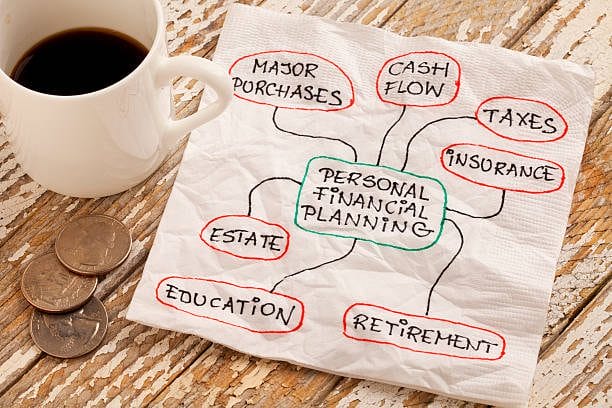
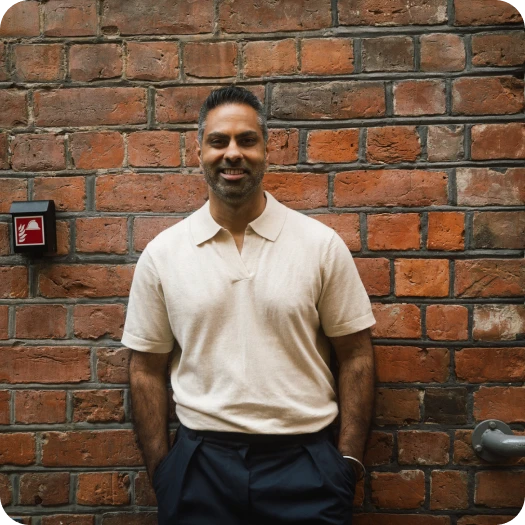
By reading this Ultimate Guide you’re already taking the first steps on your journey to a Rich Life. This is only an introduction to the ideas and material you’ll find inside IWT. I started this site in 2004 while I was studying technology and psychology at Stanford. I’ve spent the time since testing and honing my Rich Life systems on thousands of successful students.
At IWT you’ll learn -
Buy all the lattes you want. A $5 coffee is not going to change your financial life. But learning how to automatically invest, how to select the right asset allocation, and how to negotiate a $15,000 raise will. I believe in asking $30,000 questions, not $3 questions.
Your Rich Life is yours. A Rich Life can be picking up your kids every day from school. Or buying a $1,000 cashmere sweater. It can be buying a round of drinks for your friends, or traveling for 8 weeks per year. You decide. Your Rich Life is yours. (Here are some of my Money Rules.)
There’s a limit to how much you can cut, but no limit to how much you can earn. I have readers who earn $50,000/year and ones who earn $750,000/year. We’ve helped tens of thousands of people earn more money by negotiating their salaries, investing, and starting businesses.
Spend extravagantly on the things you love, as long as you cut costs mercilessly on the things you don’t. I don’t believe in cutting back on lattes. In fact, I want you to spend more on the things you love. What if you could double your spending on travel, or eating out, convenience, or charity? I call those Money Dials and I’ll show you how.
The 85% Solution: Getting started is more important than becoming an expert. You don’t need to be perfect to take control of your money. It’s OK to make mistakes. Get 85% of the way there and move on with your life.
Investing should be very boring—and very profitable—over the long term. I get more excited eating tacos than checking my investment returns. You’re in control. This isn’t a Disney movie and nobody’s coming to rescue you. Fortunately, you can take control of your finances and build your Rich Life.
Money is political. You can simultaneously acknowledge personal responsibility and real systemic problems. This is a core part of the I Will Teach You To Be Rich philosophy. Housing is political. Healthcare is political. Voting rights are political. If you’re looking for bland tips on cutting coupons, this site is not for you. I consider it a tragedy to live a smaller life than you have to. So many of us have been raised to believe that money is something to be scared of. We use phrases like “I’m not good with money” or “Money changes people.” Yes, money does change people.
Money allowed me to dream bigger, to be more generous, and to be more adventurous. It can do the same for you. A Rich Life is lived outside the spreadsheet. What’s the point of all this saving and investing if you’re simply going to wait until you’re 80 to live? No thanks. I believe that once you’ve set up your finances, you’ll see that the most important part of a Rich Life is outside the spreadsheet—it involves relationships, new experiences, and giving back. You earned it. Welcome to your Rich Life journey, I’m excited to see what you do next.
Money Management Made Simple
Good news: You don’t have to be perfect to be rich. Or the smartest person in the room. Or a type-A personality. Or lucky. In fact, you can set yourself on the road to wealth with any amount of money if you use the easy, “set it and forget it“ system I’ll show you below.
Imagine this, how would your life change if you woke up every day knowing:
- Your money was automatically going where it was supposed to.
- Your bills were paid on time every month (without you even thinking about it).
- You automatically saved money.
- You invested in all the right places without lifting a finger.
- And you even had some income left over to spend on what you love – guilt-free.
Not a pipe dream. That’s true financial freedom.
And that’s what this guide is all about. You can end your money worries, feelings of being overwhelmed, and the frustration of sifting through the mountains of financial information. And you don’t have to spend years studying compound interest charts or weeks trying to find the latest hot stocks to get there. All that’s required of you is a willingness to think about money in a different way than you’re probably used to.
Why I Wrote This Personal Finance Guide
I started I Will Teach You To Be Rich because I was tired of hearing so-called financial “experts“ telling us ALL the things we couldn’t do with our money.
- No lattes...
- No vacations...
- No buying ANYTHING we enjoy...
And after 60 years of cutting back, you just might have enough in savings to MAYBE (someday) enjoy it.
I didn’t believe it.
To me, living a Rich Life – and being in control of my money – wasn’t about cutting back on everything. I wanted more, and, if you’re reading this, I bet you do, too. We want to go out with our friends. We want to take amazing vacations. We want to buy gifts for our family, donate to charity, and live in nice places.
But how?
Back in 2004 when I first started learning about money, I had the same question. Then, I was just a frustrated college student. So I spent years reading every book I could find, watching every TV show, devouring all the financial tips and advice I could, and I finally developed my own philosophy on money.
I realized that when it comes to money:
- We need to put systems in place, rather than continuously having to choose how much to spend or save (Part 2)
- Most of us leave thousands of dollars on the table every month (and you can put that money back in your pocket with just a few phone calls… we’ll cover that in Part 3)
- When it comes to investing, you don’t need to try to beat the market (despite what financial “gurus” think… discussed in Part 4)
- And, lastly, money is only a small part of living a rich and fulfilled life.
What Does a “Rich Life” Look Like to You?
It’s an honest question that you should spend some time really trying to answer, Why do you want to be rich? Everyone’s “Rich Life” looks different.
Here’s what living a Rich Life means to me:
- Being able to help my parents save for their retirement
- Affording a personal trainer, a personal chef, and beautiful clothes
- Traveling last-minute to Asia with my friends – just because
How money really works – what the other guys don’t tell you
The problem with conventional money advice
Many of us mistakenly focus on the most pointless areas of personal finance – nobody’s taught us any other way! Should I open this credit card? I feel guilty paying for name-brand cheese. Do you think I should buy one of those coupon books? I’ll show you how to work on the right things with your money and avoid costly mistakes.
Let your money work while you sleep
Want to make your accounts work together and save automatically? I’ll reveal the exact strategies you can use to save money, pay your bills, and invest – all hassle-free and all automatic for life
Save painlessly while enjoying life’s “guilty” pleasures
Cutting back on lattes and other conventional advice simply doesn’t work. Why have money if we’re not allowed to spend it? I’ll show you how to spend your money guiltfree on what you love while cutting costs mercilessly on what you don’t.
Build your bulletproof portfolio
How would you like to have a portfolio of investments – and all the right retirement accounts – that puts stock-pickers and financial “experts” to shame? I can help you get there with some simple (but ultra-effective) investing strategies.
Pay off your debt
If you have credit card debt — even if you aren’t sure exactly how much you have — I’ll show you how to pay it off faster.
Earn more money
Let me give you a life-changing fact: there’s a limit to how much you can save but no limit to how much you can earn. Earning more money is the fastest and biggest way to improve your financial situation. And you don’t have to go back to school, change careers, or even learn new skills to up your earning power.
Part 1 - Money mistakes that cost you millions (what to avoid)
First, here’s what this guide is not:
- Your parents’ old money management and investing advice
- An economics textbook that takes a math degree and 10 years experience to understand
- Frugality that demands you pinch pennies and cut back on everything
In this guide, we’re going to stop the overwhelm, confusion, and frustration. You’ll get five simple steps to create a personal money management system that practically runs itself.
Before we get there, let’s start with what keeps us from being effective with our money
If you avoid making costly money mistakes, you can save hundreds of thousands – if not millions – of dollars over your lifetime. Knowing what NOT to do with our money is half the battle.
Mistake #1 - Debating minutiae
Did you ever wonder why so many people get fat after college?
After I graduated from Stanford, I noticed a lot of my friends – the same ones who used to say things like, “There’s no way I’ll ever get fat!” – packed on the pounds a few years later. Why is that? Weight gain doesn’t happen overnight. Instead it creeps up on us a few pounds at a time. And before we know it, we look up and we’re 20 lbs heavier.
So what do we do? We overwhelm ourselves with small choices (Which brand of protein bar to buy? Which running shoes are the best?) instead of focusing on the big wins of eating less and exercising more. If you think about it, money works the same way.
We spend years obsessing over every single, tiny financial detail and never take action.
Before we know it, we’re in a bad situation and getting out seems overwhelming.
Or worse, we just ignore the topic of money completely because it makes us feel guilty, like our fitness or food. Both options lead to the same results: None!
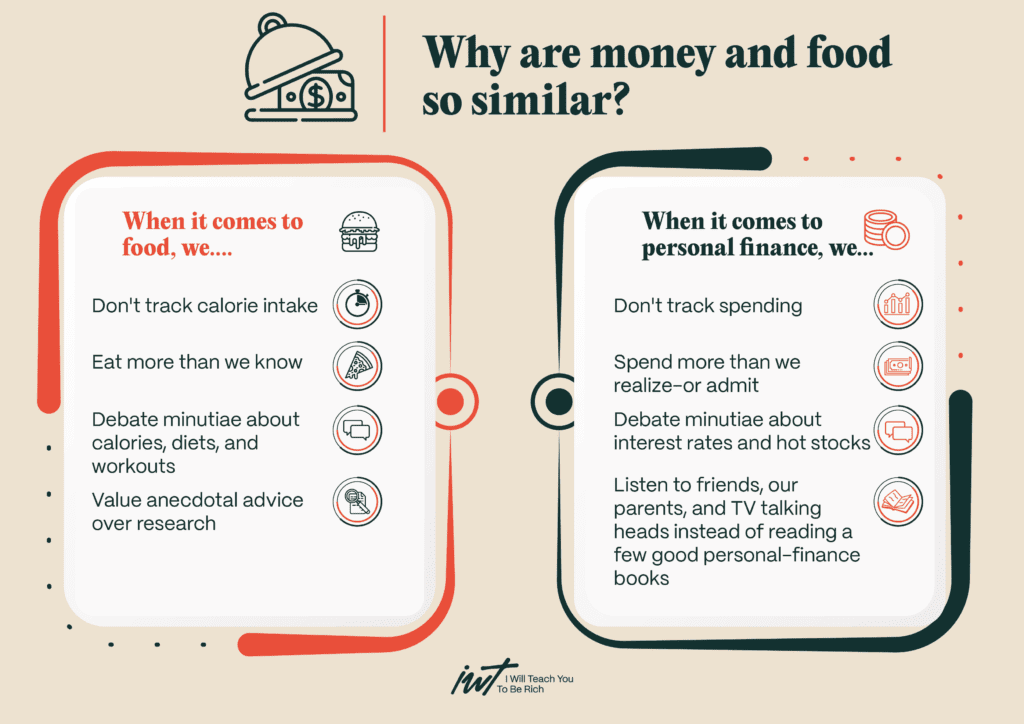
Just like with our fitness, when it comes to our personal finances, most people only need to focus on two things: setting up reliable, no-fee bank accounts with automated savings and bill payments and investing earlier on in life so we can let our money grow for 30+ years. But that’s not as sexy as chair-throwing and ratings-driven cartoons on TV calling out thousands of complex investments you need to make. And it’s not as tactical as the penny-pinchers who tell you to stop spending on everything.
But it is what works.
Mistake #2 - Relying on Willpower

These are actual, real articles that someone wrote about how to save money.
You won’t find that kind of advice here. If frugality is what you’re after, please go back to 2 hours of carefully separating toilet paper by hand to save $1.42 a week. If you don’t want to be that person, I want to show you how to actually save money without guilt, frustration, confusion, or constantly being bombarded with terrible money advice. “Keep a budget!” and “Cut back!”
None of this advice is applicable in the real world, but frugalistas keep touting it as if it’s their religion.
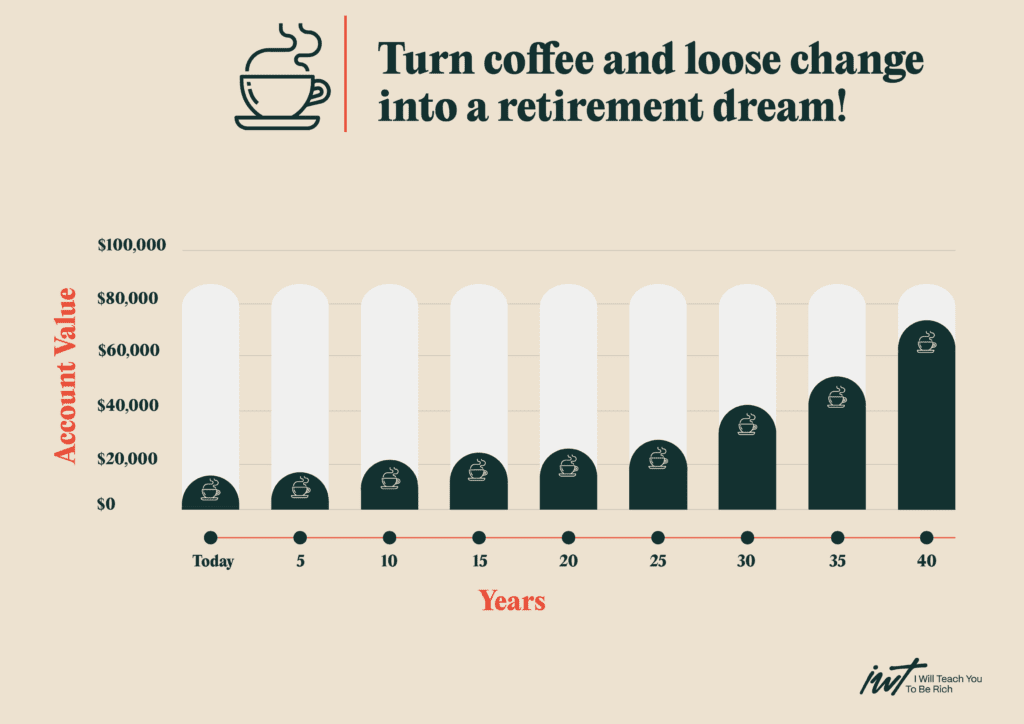
Why doesn't this work?
-
- We have to make this choice EVERY DAY. Regardless of factors like we love Starbucks caramel double lattes, we’re feeling stressed, or we drive by the coffee shop on the way to work, we have to use our limited willpower first thing in the morning, every day, forever. And what these no-latte finger-waggers aren’t taking into account – as they gorge on their homemade coffee – is that every decision we make to not buy that latte, to not consume that, to not have that depletes our willpower.
- Even if we’re “successful,” we don’t invest the money we’ve saved. You’ve skipped morning coffee every day for 365 days. You have $730 dollars, right!? Probably not. $2/day is not significant enough that you’ll “see” the savings at the end of the month. Unless you physically put aside $2 every single day. Which brings us back to point #1. And even if you do it, how do you invest it? What account do you put it in? It’s easy to see how this becomes much more complicated than putting grounds in your coffee maker.
Mistake #3 - Thinking you can wait
Procrastination is a silent, but slow killer for your money.
We all put things off, of course. But waiting until the last minute to get smarter with our money is one of the worst things we can ever do. Every year we wait to get started with investing and saving puts a huge dent in our long-term financial plans. Here’s an example.
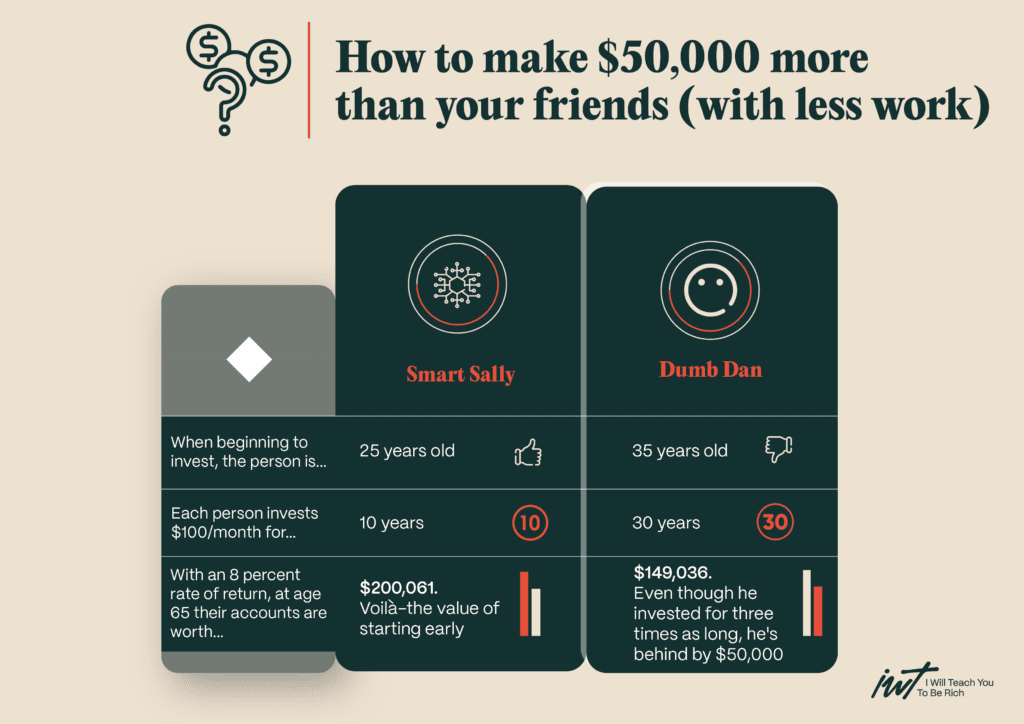
Look at the chart carefully. Smart Sally actually invests less than Dumb Dan, but ends up with about $50,000 more. She invests $100/month from age 25-35 and never touches her money again. Dumb Dan on the other hand WAITS to do anything with his money. He doesn’t start investing until he’s 35. Then he invests the same $100/month every year until he’s 65. So Smart Sally only invested her money for 10 years while Dumb Dan invested for 30, and she still comes out nearly $50,000 ahead with less work.
I want to help you get started today.
Part 2 - Automate your money
Build a system that saves while you sleep and pays your bills for you
There are a lot of broke finance professors out there. People who know the ins, outs, ups, and downs of money, yet they’re deeply in debt. How can that be? Because information alone is not enough. Especially when it comes to managing money, 80% (or more) of your long-term success comes down to your behavior around saving, spending, and investing. The other 20% comes from knowing what to do. That’s why I put this section in the front of this guide. If this is the only section of the guide you read, you’ll be ahead of 99% of people.
- Your behavior of spending, saving, and investing will all be automated
- You won’t have to force yourself to do a thing
- All of your money will go where it’s supposed to – automatically
Don’t even think about stocks or learning about derivatives until you’ve done this first. This is the cornerstone to mastering your personal financial system.
Make saving painless and spending guilt-free
One reason we don’t save money is the pain of putting money into our savings accounts each month. Just like cutting back on lattes, we may do it once or twice but if we have to make the decision EVERY paycheck, we’re setting ourselves up to fail.
That’s why automated finances work so well. By setting up a bulletproof personal finance system, you can start to dominate your finances by having your system passively do the right things for you.
It will help you automatically manage your money, guilt-free, for years to come. Bills, payments, and savings will be automated, leaving you to focus on the things that really matter.
And since the system is so flexible, you can tweak it to your specific situation.
Below is a video of a 11-minute guide on how to set up your money and accounts to automatically pay bills, save, and even invest every month: Your behavior of spending, saving, and investing will all be automated.
The video explains the exact steps needed to set up your money-saving system so your money automatically “flows“ to where it needs to go, and requires little maintenance each month.
Check out how it works:
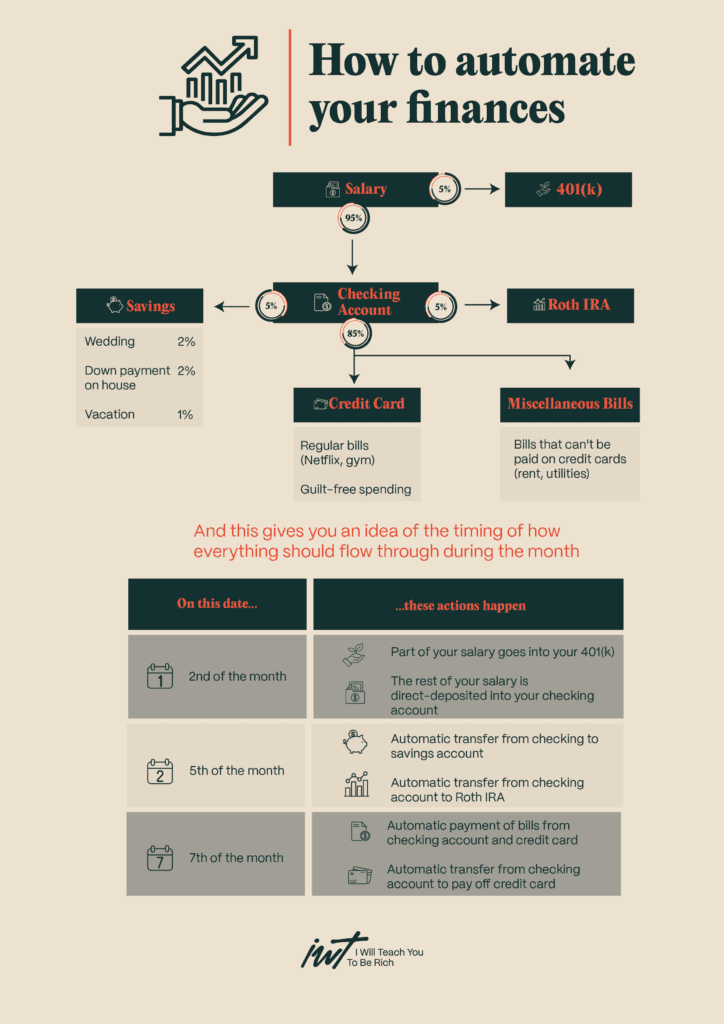
Then, you know exactly what you have left to spend (guilt-free) each month.
$5 latte? Sure! A round of drinks with friends? Absolutely.
The Hidden World of Conscious Spending: How you can save hundreds per month while still buying what you love
I’m not the guy who wags his finger and tells you, “No, you can’t do that. It costs too much.”
I say, “Okay, so you want to buy that expensive pair of shoes? Cool, let me show you how you can actually get it.”
Unlike most people in the personal finance world, I actually spend lots of money eating out and traveling, and never feel guilty.
Rather than taking a simplistic view of “don’t spend money on ANY expensive things,” there’s a much more nuanced approach to spending.
It starts with this mindset.
The only problem is most people aren’t deciding what’s important to them and what’s not.
Let’s take a look at a case study to see how you can decide what’s important to you and build a plan of Conscious Spending.
Case Study: How my friend spends $21,000 per year on just going out
My friend spends over $21,000/year going out. Most people’s reaction to that: “OH MY GOD, THAT’S SO MUCH*#%(#%(#%!”
But let’s break it down and see. Is it really extreme?
Let’s say you go out 4x/week – to dinners and bars – and spend an average of $100/night.
I’m being conservative with the numbers here, since a dinner can run $60/person and drinks could be $12 each. I’m not including bottle service, which might cost $800 or $1,000. (He lives in a big city.) That’s easily $400/week.
Now, this guy also makes a healthy six-figure salary, and he’s invested quite a bit in his 401(k) and outside investments (including real estate). The key here is that he works such long hours that he’s only really free Friday and Saturday nights. And so he goes out. Hard.
In just a couple of years, this guy has saved more than almost any of my friends. But he’s also spent more on going out than anybody I know.
And although $21,000 sounds outrageous on the surface, you have to take context into consideration.
For example, look at his spending by percentage: Just for easy calculations, if we assume that this guy makes $210,000/year net, his going-out budget is roughly 10% of his income.
For my friends who make $35,000/year, you can be damn sure that they’re spending more than $3,500/year ($67/week) on going out.
But my other friend has a plan and he’s decided to spend his money this way.
Most of us are not consciously thinking about our spending.
By that, I mean we’re not being proactive about planning where our money should go.
We’re going through life doing whatever, and inferring our spending patterns from the bills we get at the end of the month.
We not only lack a prescriptive budget (“I want to spend 20% on my retirement account, 10% on savings, 20% on going out…”), we even lack a descriptive budget (“Where the hell is my money going?”).
You can spend on the things you love, too, but it takes a plan. And it’s really as simple as that.
How you can make your own Conscious Spending Plan
This can be hard, but I’ll try to make it as painless as possible.
First, categorize your spending: Know where your money goes so you’re in complete control of every decision. Conscious Spending is about making a plan on how you want to spend your money.
Then, optimize your spending to fit these recommendations:
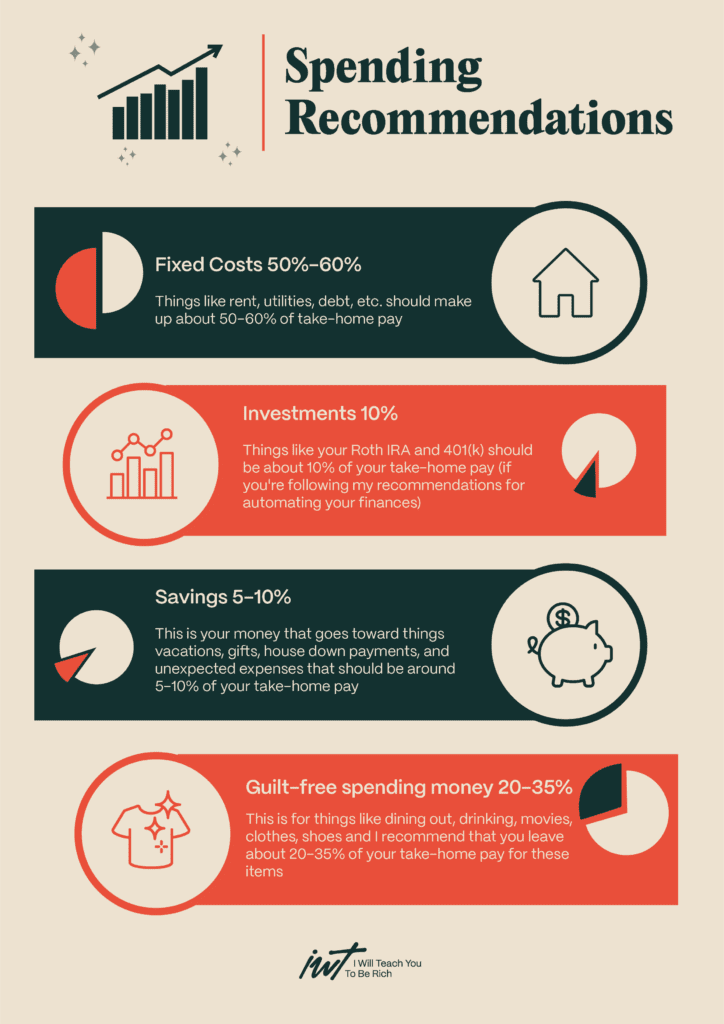
Add them up.
Now to find the the categories you’ve yet to fill out, you’re going to have to go a little deeper. Just take last month’s expenses as an example. Just look at a recent credit card or bank statement to do this.
Now, subtract these amounts from your take-home pay, and you’ll have a sense of what you have left over for the other categories of investing, saving, and guilt-free spending.
How to plan for unexpected expenses…
One of the most common reasons people can’t get ahead is expenses they just didn’t expect. These “unpredictable” expenses are very predictable.
Here’s the trick: A lot of what seems unpredictable is extremely predictable — over the long term. What seems like surprise expenses are actually not a surprise if you analyze your spending for the past 5 years. Which of course nobody does.
For example, that “surprise” car repair? It might not happen in the same month, but every year, you might average spending about $400 on car repair. That’s $33/month. Once you know that, set up an automatic deposit into your sub-savings account and you’re done.
Keep a “Stupid Mistakes” sub-savings account
I keep a sub-savings account called “Stupid Mistakes” in my Capital One 360 account. (formerly ING Direct)
I save $100/month into it. If there’s anything left at the end of the year, I take out 20% to reward myself, and roll the rest back into my main savings account.
Keep a “Stupid Mistakes” sub-savings account. Just the simple fact of having one will sharpen your focus on avoiding the mistakes in the first place. And when you do make a stupid mistake, you’ll be able to use your sub-savings account as a buffer to keep your automation system on track.
Have you read my New York Times Bestselling book?
You can read the first chapter for free – just tell me where to send it:
Part 3 - Tap into “hidden income”– money you’re throwing away every month
Now that you have your money automatically going where you want it go, let’s get some extra cash flowing into all of your accounts.
You can have more money to save and invest (we’ll cover investing next) by spending less on the things you’re already paying for.
Instead of strict budgets or extreme frugality, this section will show you how to free up your cash so you can jet off for the long weekend, buy that new jacket, or get to zero faster on your credit card balance.
This is how you can gain an unfair advantage when saving money. (Hint: It starts with money you’re sending out the door every month.)
Fundamentally, there are two ways to have more money. You can either earn more money or cut costs. Negotiation skills are the most powerful tools to have in your “hidden income” toolbox, because if you know how to negotiate, you can do both (by negotiating a raise at your job or negotiating a lower rate on every bill you pay).
Instead of cutting back on the things we love, we can save on the things we hate by paying lower prices using the negotiation strategies I’ve outlined below.
- Bank and Credit Card fees
- Car Insurance
- Cell Phone
A few one-time, 5-minute phone calls can save you thousands every month.
I’ll teach you, in detail, some easy ways to save money on bank and credit cards fees, your car insurance and your cell phone bill – all potentially worth thousands of dollars each year – no willpower needed.
The video you'll see below, covers the exact steps to call 5 companies and save thousands (Including some of the word-for-word scripts).
Your turn: Beat these companies at their own game
How to negotiate lower car insurance
Most of us pick a rate for our car insurance once, then never look at it again.
But if you do, you can save hundreds of dollars each year.
- Coverage options: First, you’ll want to check to see if you have the right amount of coverage. Nobody teaches us about this stuff, so when you bought car insurance, you may not have known which coverage options to choose.
- Your current plan: Second, figure out what kind of coverage you currently have and how much you’re paying. Don’t be lazy — do this. If you don’t have your current info in front of you, how can you hope to save? Either call your car insurance company or use their website.
- Shop around: Third, it’s time to start shopping around. I prefer the phone because I can usually sweet-talk the rep into telling me about other deals that the websites don’t offer. Computers, however, seem to be immune to my charm. I made it easy for you. Here are the phone numbers of the big insurers:
-
- Geico: (800) 861-8380
- AAA: (800)-222-4357
- Allstate: (800)-726-6033
- Progressive: (800) 776-4737
- State Farm: You can get to their auto insurance site here.
- 21st Century Insurance: Don’t use this worthless insurance company.
I used to use them, but they sent me multiple envelopes in the mail EVERY SINGLE WEEK until I finally canceled them. The rates were great, but the hassle wasn’t worth it.
4. Ask these questions: Fourth, be an expert caller by asking these questions. With each call, you should say, “AAA (or whoever) is offering to insure me for $XXX less” (silence). See what they do. (Note: Negotiating lowering insurance using this technique is much harder to do with car insurance companies than banks, so don’t expect very much from this.)
AAA, Costco, credit cards, large employers, associations (AARP, teachers’ union): Many of these offer discounts on car insurance. Log onto their website and browse to “perks.”
It seems like a lot of work, but the savings are substantial.
“Negotiating” lower car insurance is mostly about keeping up with the changing rates and making sure you’re wringing every last benefit from your policy, so set a calendar reminder to do this once per year.
Cut your cell phone costs
Cell phone companies have this wildly curious business model of acquiring tons of customers through very expensive means (e.g., national advertising), then churning through them by treating them horribly. Yet even they know that it’s cheaper to retain an existing customer than to acquire a new one. You can use this “customer acquisition cost” in your favor.
Here’s how:
- Find comparable plans for your usage on other cellphone networks. For example, I’m with AT&T, so I’ll investigate Verizon, T-Mobile, and Sprint by going to their websites. Write down how much they each cost, how many minutes you get, and any other benefits.
- Call your current cellphone company. To make it easy, here are the phone numbers:
AT&T: 1-800-331-0500
Verizon: 1-800-922-0204
T-mobile: 1-800-T-MOBILE
Sprint: 1-866-866-7509
3. First, be nice. Ask them what better plans they have to offer you
You: “Hi, I was looking at my plan and it’s getting pretty expensive. Could you tell me what other plans you have that would save me money?”
Them: Blah blah same plans as on the website blah blah
You: “What about any plans not listed on the website?”
Them: No, what we have is listed on the website. Plus, you’re on a contract and have an early cancellation fee of $XXX.
You: “Well, I understand that, but I’d be saving $XXX even with that cancellation fee. Look, you know times are tough so I’m thinking of switching to [COMPETITOR COMPANY]. Unless there are any other plans you have…? No? Ok, can you switch me to your cancellation department, please?”
Note: What you really want is to be switched to their “customer retention” department, which is the group that has the ability to retain you by giving you a bunch of free deals. You can either ask to be switched directly to the customer retention department, or play a game and hope that by asking for “cancellation,” you’re actually transferred to retention.
Play around with a few phone calls and see what works best. When you get to the customer retention department, ask for the same thing. This is when you pull out your competitive intel on the other services being offered. If Verizon is offering something for $10 less, tell them that. That’s $120 savings/year right there. But you can do more.
You: “Listen, you know times are tough and I need to get a better deal to stick with you guys. You know and I know that your customer acquisition cost is hundreds of dollars. It just makes sense to keep me as a customer, so what can you do to offer me this plan for less money?”
Use this technique on virtually any subscription you’re paying. Businesses want to keep customers and are willing to negotiate – but since most people don’t, they’re leaving money on the table.
Notice that you didn’t say, “Can you give me a cheaper plan?” because yes/no questions always get a “no” answer when speaking to wireless customer service reps.
You also invoked the customer-acquisition cost, which is meaningful to retention reps.
Finally, it really helps if you’re a valued customer who’s stuck around for a long time and actually deserves to be treated well. If you jump around from carrier to carrier, you’re not a worthwhile customer to carriers.
One final thing: People get scared that if they go to the cancellation department and try to negotiate, they’ll get their account canceled without really wanting to do that.
There are two things to remember about negotiating your wireless bill:
(1) You have a MUCH stronger position if you’re actually willing to walk away and switch to another plan, and
(2) your account will never get canceled until you say the final word. You can negotiate for 3 hours and walk away if you want.
Get yourself out of credit card debt by negotiating with your bank
Use the tips in the video above to pay a lower rate on your credit cards
When it comes to paying off debt, one of the best ways to make a huge dent in it is to pay a lower rate. Even saving just a few percentage points on your credit card bills can be worth thousands over time.
The key? Most people don’t do this, but it can make all the difference if you do. You’ll not only be able to pay off your debt faster (with the same size payments) but you also won’t be losing nearly as much money to interest.
Do this once and reap the rewards for years to come
Bad things to say when negotiating bank fees:
- “Are you sure?” Don’t make it easy for the rep to say no.
- “Is there anything else I can do?” Again, imagine if you were a customer service rep and someone said this. It would make your life easier to just say “NO.” As a customer, don’t make is easy for companies to say no.
- “Well, this Indian blogger dude told me I could.” Nobody cares… but it would be cool if 1,000 customers called their banks and said this.
- “Okay.” Don’t give up here. “No” does not mean “no” when it comes from a bank.
Try these techniques to negotiate bank fees instead:
I’ve been with the bank for many years, which you should always use to your advantage when calling to complain. Banks pay hundreds and sometimes even thousands of dollars in customer-acquisition costs and don’t want to lose you.
Key Takeaways:
- Mistakes happen, but don’t be dumb and overdraft consistently.
- When complaining, have a clear goal and don’t make it easy for companies to say “no“ to your complaint.
- “No“ is the beginning of the conversation.
The world wants you to be vanilla...
…but you don’t have to take the same path as everyone else. How would it look if you designed a Rich Life on your own terms? Take our quiz and find out:
Part 4 – Start to invest – simply and effectively
I’m about to share the investing advice I wish I had when I first started learning about money.
Back then, I tried to “beat the market,” and lost half of my very first college scholarship check. So if you’ve ignored your retirement account until “later” or thought about picking stocks based on how “hot” they are at the moment, this section is for you.
You’ll learn how to invest your money for the long-term (without worrying about stock prices every day) – all clearly laid out and easy to understand.
Why most people don’t invest (And why they’ll never be rich)
A lot of us are simply scared to put our money in the market. And for the most part, we have every reason to feel that way.
On one hand, you have media moguls who scream financial crisis at even the slightest dips in the market to drive up their ratings. On the other hand, we’ve just come out of one of the biggest stock market crashes in generations.
Some of us have even watched our families and friends be forced to keep working instead of retire on time.
All that really is scary. But, if you believe the market will recover (which it has) and grow over the long term, you need to be investing consistently.
Other reasons people don’t invest? “I don’t have time” and “I don’t want to lose money.”
I get it. Nobody just LOVES spending time managing their money and, certainly, nobody likes losing it.
But I’ve taken the pains to research investment strategies that don’t take lots of time to maintain and can still pay off in a major way.
One quick note: When it comes to investing, nobody can guarantee returns, and if they do, you should probably run the other way.
But if you believe that the market will – over the long-run – continue to recover and grow, you should keep investing. (Or start by setting up your accounts today)
Consistency is the key and we’ll talk about how you can do that with minimal effort using a complete investing system. And, trust me there’s no better time to start than today.
The Biggest Investing Myth
(and the best time to start)
One of the biggest myths about investing is that you have to be a super smart stock-picker to make money.
This drives me nuts because it’s simply not true.
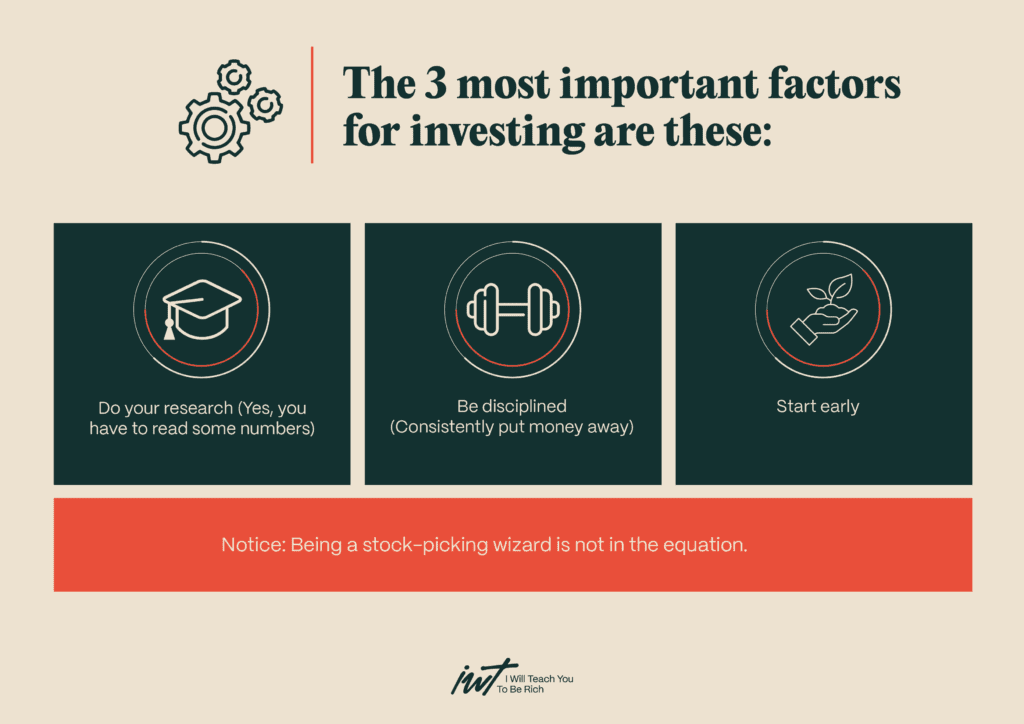
I want to hammer home the last bullet because starting early gives you a monster advantage.
Here’s why:
If you’re 25 years old and you save $100/month until you’re 35 (for only 10 years, then you never save money again), and your dumb friend starts later – saving $100/month from age 35 to 65 (that’s 30 years compared to your 10 years) – you will have way more money (over $50,000 more) than him at age 65.
It’s not hard to become rich. But it takes work and consistent saving, and so it’s easier for a lot of people to shrug their shoulders and put it off for another day. Unfortunately, every extra year you wait to start investing makes it dramatically harder to make the same amount of money
Start early and you will be rich.
The Importance of Investing Now
You are not getting any younger.
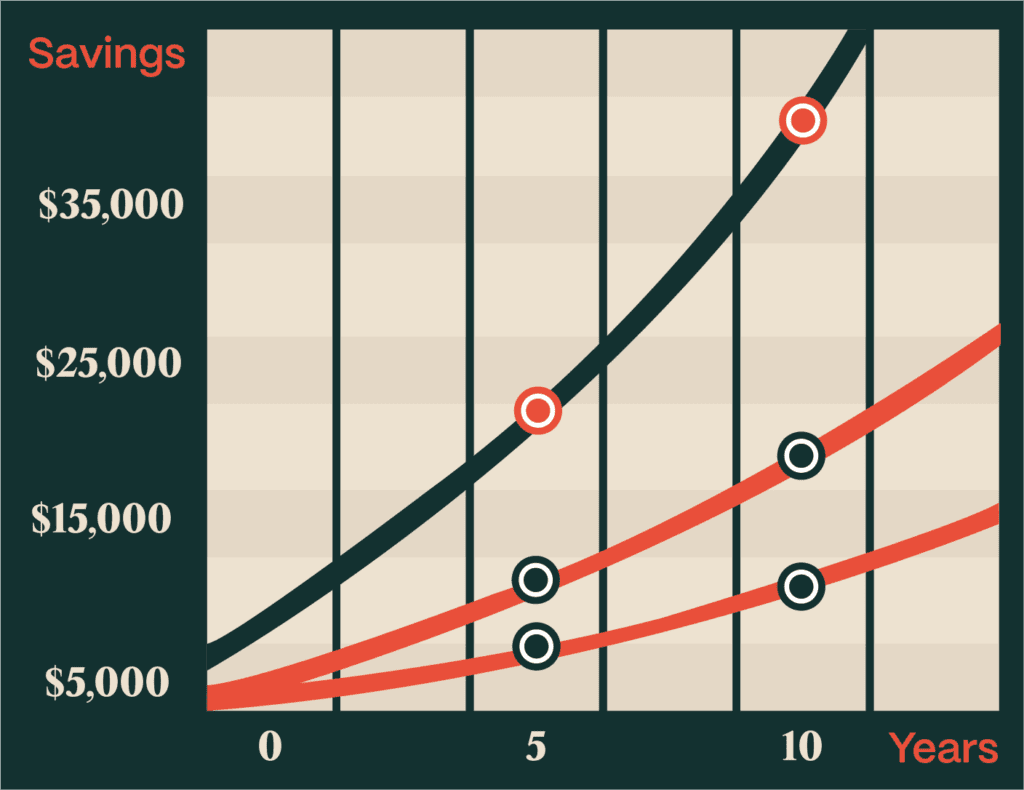
What if you had started investing $10 per week five years ago, receiving an average 8 percent return? Guess how much you’d have?
It turns out that by now, you’d have thousands of dollars – all from investing a little more than $1 per day. Think about that $10 a week – where did it go, anyway?
If you’re like most people, it probably slipped through your fingers on random things like cab rides and lunches. Despite wild rides in the stock market, with a long term perspective, the best thing you can do is start investing early.
And the number one money-related regret for older people is not investing early!
I’m not a old man yet, but when I see these numbers, it’s tempting to run around with a cane and a vodka tonic in hand, screaming at young people. Not only do we fail to invest our money, but we don’t even know why it’s important!
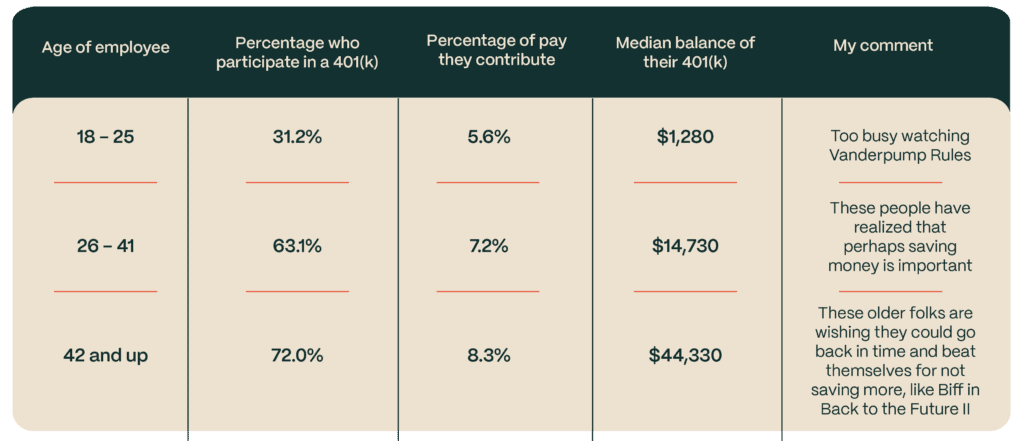
Key Takeaway
(even if you’re not super young)
No matter what stage of life you’re in, the most important thing and my goal is to get you started and make it easy to maintain your investments.
By doing just those two things, you’ll be on the way to getting rich.
And setting up your investment accounts is an excellent first step toward actually investing (we’ll cover how you can below).
But, the first thing to note is that you don’t have to be rich to open an investment account.
Most account providers actually waive the minimums if you set up automatic transfers (which is what we’re all about).
Investing is NOT about stock picking
Really it’s not. Nobody can reliably pick stocks that will outperform the market over the long term. Thinking you can beat the market is an easy way to make mistakes and become overconfident in your abilities.
Even “experts” cannot guess where a stock will go next. Just turn on CNBC and watch the dazzled looks on the pundits’ faces when they make a wrong call on a stock.
Plus, having to pay attention to the latest hot stock or every micro-change in the market is risky and involves a lot of guesswork.
I prefer investing in low-cost, diversified funds consistently, rather than chasing stocks and relying on guesswork to get through.
That’s the same strategy recommended by Nobel Laureates and billionaire investors, like Warren Buffett.
With this strategy, you can effectively trick yourself into investing because it requires no work on your end.
Setting up Your Accounts
The Magical Benefits of Retirement Accounts
Many people mistakenly think that retirement accounts are just places for you to save money until you’re 65.
Actually, they offer you humongous benefits if you agree to save for a long-term horizon. Let’s compare regular (taxable) investment accounts with retirement accounts.
Regular Investing Accounts
When you open up an account at E*Trade, Scottrade or whatever, you’re generally opening up a regular investing account, which is also called a taxable account.
This means that when you sell your stocks, you’ll pay taxes on your gains – and if you sell your stocks in less than a year, you’ll pay a huge amount (regular income tax rates, like 15% or 30%). Let’s not get bogged down in the details. As we talked about earlier, buy-and-hold investing wins over the long term. And because of the way taxes are structured, you pay a penalty for trading too frequently.
But there’s an even stronger advantage to holding your money for longer – say, until retirement.
Retirement Accounts
Retirement accounts, quite simply, give you huge tax/growth advantages in exchange for your promise to save and invest for the long term.
Now, this doesn’t mean that you have to hold the same portfolio for 30 years. You can buy and sell shares of almost anything as often as you want. But with a few exceptions, you have to leave the money in your account until you get near retirement age.
Here’s how the magical benefits work:
In a retirement account, you get big tax benefits. While 10% or 20% may not seem like much in 1 year, when you compound that over 30 years, it becomes a gigantic amount.
In fact, if you were to start a retirement account next week, two things will happen: (1) You will be more financially prepared than 99% of your peers, and (2) you will be rich.
Yeah, I said it: If you start a retirement account in your early 20s or 30s and fund it regularly, you will be rich.
Let’s look at a simple comparison of investing in a retirement account vs. just investing in a regular, taxable account:
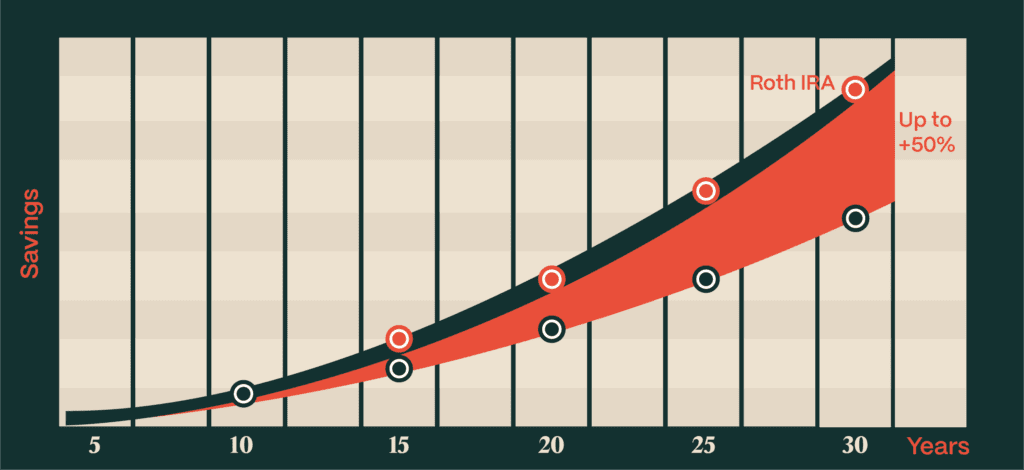
Don’t worry about the exact amounts. Just notice the difference in how much you earn – especially at the end.
A retirement account – whether it’s a Roth IRA, 401(k) or something else – lets your money grow at an accelerated rate with hardly any extra work from your end.
Now let’s get into the details.
Mastering your 401(k):
How to Get Free Money and Get Rich
A 401(k) is a type of retirement account. If you work for a company, chances are you already have a 401(k) offered to you.
Here’s how a 401(k) works: You put pre-tax money into the account, meaning you haven’t paid taxes on it yet.
Let’s look at why that’s important. In regular, taxable investment accounts, you pay taxes on your income and then invest it.
So for every $100 you make, you might actually only be able to invest $85 of it. 15% (or whatever, depending on your tax rate) goes to the tax man.
A 401(k) is different. You can invest the entire $100 and let it grow for about 30 years. That extra ~15% turns out to make a huge difference as it gets compounded more and more.
401(k) Matches
There’s an extra benefit, too: Your company might offer a 401(k) match.
For example, a 1:1 match up to $2,000 means that your company will match every dollar you invest up to $2,000; therefore, investing $2,000/year really means you’re investing $4,000/year. Woah.
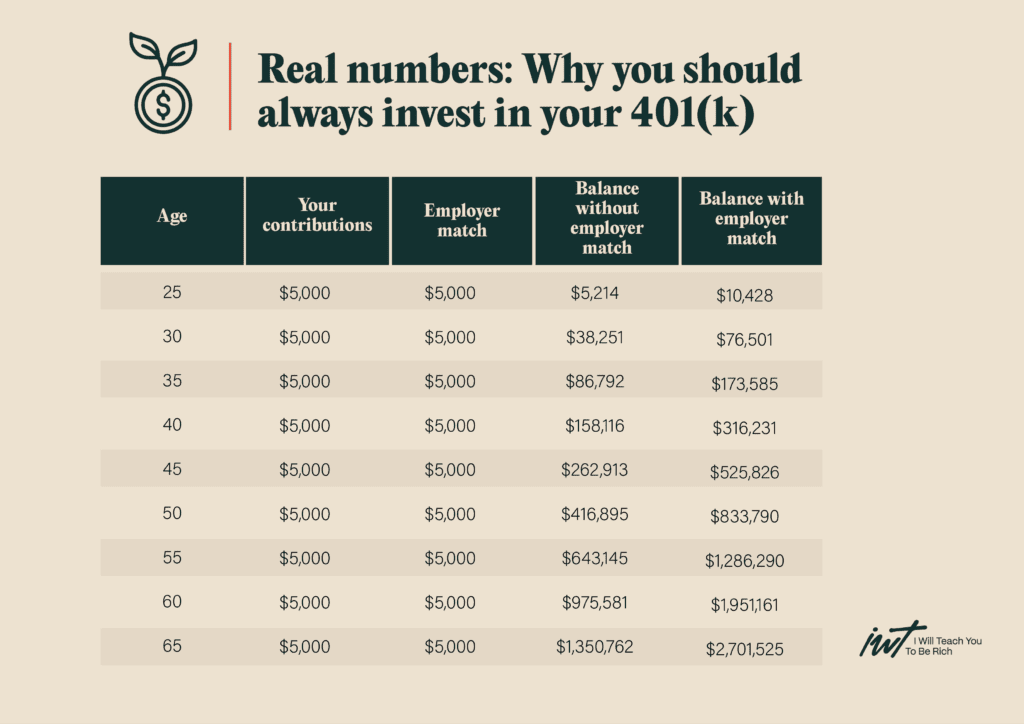
This is free money and you absolutely, positively need to participate if your employer offers a 401(k) match. It doesn’t matter what kind of debt or expenses or whatever you have – if your company offers a match, do it.
So what exactly happens when you contribute money to your 401(k)?
Basically, it goes into an investing account where a professional investing company manages it. You can choose from a bunch of different investing options, like aggressive, mixed, international, etc. Honestly, it’s like McDonald’s for investors: Anyone can do it. The hardest part is making the first phone call to HR to get it set up.
Summary of the 401(k) Advantages
There are a lot:
- You get to put pre-tax money to work (i.e., money you haven’t paid taxes on yet, so there’s more of it to grow).
- Your company might offer an insanely lucrative 401(k) match, which you must take.
- And it’s not that hard to set up – your company does most of the work. In fact you can instruct them to automatically withdraw a certain amount from every paycheck.
- Don’t worry about switching jobs: If you leave your company later, you can take your 401(k) with you.
And be aggressive with how much you contribute to your 401(k) because every dollar you invest now is worth many more times that in the future.

401(k) restrictions
The 401(k) isn’t tax-free, though. There are a few restrictions.
- First, the government has to get its tax revenue sometime, so you’ll pay ordinary income tax on the money you withdraw around retirement age. (Remember, though, that all that money has been growing “tax-deferred” for ~30 years.)
- Second, you’re currently (in 2015) limited to putting $18,000/year in your 401(k).
- Third, and this is important, you’ll be charged a big penalty of 10% if you withdraw your money before you’re 59.5 years old.
This is intentional: This money is for your retirement, not to go out drinking on Saturday.
You can call up your HR representative on Monday and get enrolled in your 401(k).
Start an automatic-payment plan so money is taken directly from your paycheck.
Mastering Your Roth IRA
If you want real wealth in your retirement, you absolutely need a Roth IRA. It’s another type of retirement account.
And every person should have a Roth IRA. It’s simply the best deal out there for long-term investing.
Remember how your 401(k) uses pre-tax dollars and you pay income tax when you take the money out at retirement?
Well, a Roth IRA is different than a 401(k). A Roth uses after-tax dollars to give you an even better deal.
Here’s how it works:
When you make money every year, you have to pay taxes on it. With a Roth, you take this aftertax money, invest it, and pay no taxes when you withdraw it.
If Roth IRAs had been around in 1970 and you’d invested $10,000 in Southwest Airlines, you’d only have had to pay taxes on the initial $10,000 income.
When you withdrew the money 30 years later, you wouldn’t have had to pay any taxes on it. Oh, and by the way, your $10,000 would have turned into $10 million.
Think about it.
You pay taxes on the initial amount, but not the earnings. And over 30 years, that is a stunningly good deal.
Roth IRA Restrictions
Again, you’re expected to treat this as a long-term investment vehicle.
You are penalized if you withdraw your earnings before you’re 59.5 years old. (Exception: You can withdraw your principal, or the amount you actually invested from your pocket, at any time, penalty-free. Most people don’t know this.)
There are also exceptions for down payments on a home, funding education for you/partner/ children/grandchildren, and some other emergency reasons.
And there’s a maximum income of $181,000 to make full contributions to a Roth. But you can read about those later.
What’s the big takeaway from all those restrictions and exceptions? I see 2 things:
First, you can only get some of those exceptions if your Roth IRA has been open for 5 years. This reason alone is enough for you to open your Roth IRA on Monday.
I want you to research it this weekend, and I want your Roth IRA opened by next week.
Second, starting early is crucial. I’m not going to belabor the point, but every dollar you invest now is worth much, much more later. Even waiting two years can cost you tens of thousands of dollars.
Currently, the maximum you’re allowed to invest in your Roth IRA is $5,500 a year (updated in 2008). I don’t care where you get the money, but get it. Put it in your Roth and max it out this year.
These early years are too important to be lazy.
Open Your Roth IRA
It’s easy. You can go through your current discount brokerage, like E*Trade or Scottrade.
Below you can see a video I have created to help show you how to choose a Roth IRA
Next, call them up, tell them you want to open a Roth IRA, and they’ll walk you through it. Special note: These places have minimum amounts for opening a Roth IRA, usually $3,000. Sometimes they’ll waive the minimums if you set up an automatic payment plan depositing, say, $100/month.
Shop around though.
Once your account is set up, your money will just be sitting there. You need to do things then:
- First, set up an automatic payment plan so you’re automatically depositing money into your Roth. How much? Try doing as much as you’re comfortable with, plus 10%.
- Second, decide where to invest your Roth money. I recommend low-cost, diversified index funds as the best option or target date funds.
401(k) or Roth IRA?
The simple answer is both: These accounts, while conceptually different, work together pretty well.
Here’s how I think about it.
- First, I would max out any 401(k) match that my company provides.
- Second, I’d max out the $5,500 for my Roth IRA.
- Third, I’d max out the rest of my 401(k), up to $15,000.
- Finally–if your employer doesn’t offer a 401(k), you’re not employed yet, or you still have money left over–I’d open a regular, taxable investment account and put money there in stocks, index funds, etc.
Why Max Out Your Roth IRA Before Your 401(k)?
Well, there’s a lot of dorky debate in the personal-finance world, but the basic reasons are taxes and tax policy: Assuming your career goes well, you’ll be in a higher tax bracket when you retire, meaning that you’d have to pay more taxes with a 401(k). Another common reason for the Roth is that tax rates are considered likely to increase.
Remember: Your 401(k) money is taxed at the end, while Roth IRA money is taxed right away and then grows tax-free.
What To Do Today
When it comes to money, it’s very easy to end up like most people – just doing nothing.
So let the fools debate. For you, just get your accounts open.
Part 5 – Eliminate Your Debt
If your net worth is in the red, it makes it hard to even conceive investing or saving your cash.
So let’s eliminate your debt, once and for all.
Debt sucks. We know that credit card debt is one of the biggest barriers to living a rich life.
Debt prevents us from enjoying ourselves and investing in ourselves. And worst of all, it buries us in guilt and fear.
We can help. We did some research with our top students to see what works (and what doesn’t) when it comes to paying off your debt.
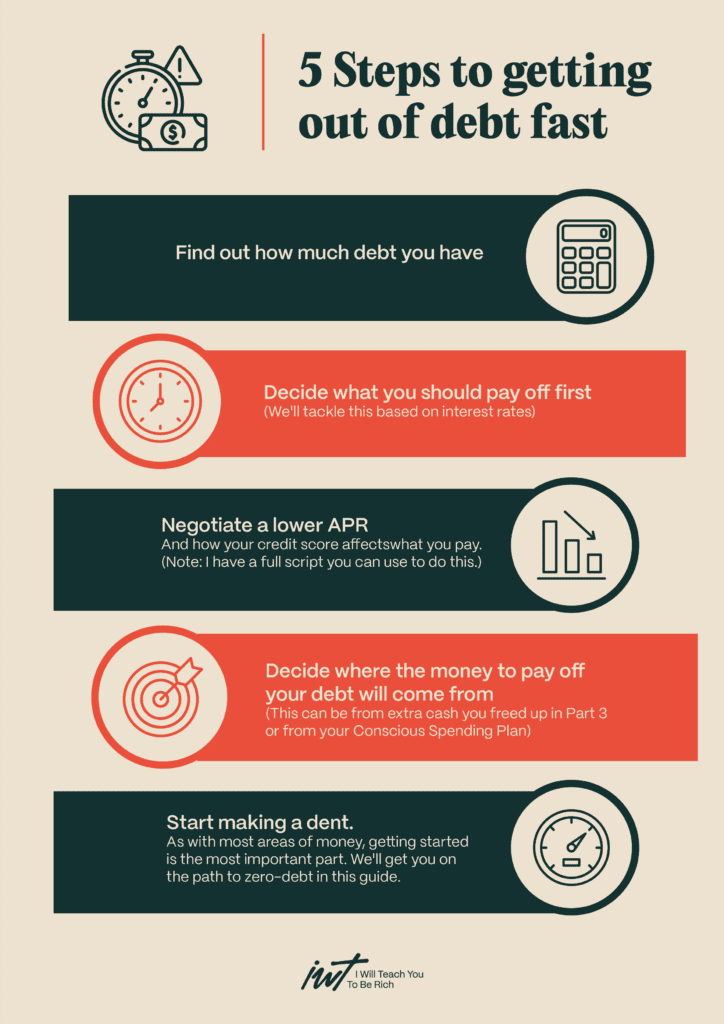
How Much Do Things Cost if You Finance with a Credit Card?
To show you how costly not paying down your debt can be, I wanted to give you a quick example of simple items that could be costing you thousands more because you haven’t tackled your debt strategically.
Take a quick look at this table with a few examples of how much more expensive things get once you finance them with credit cards and minimum payments.
Guess how much an iPod costs if you finance it with a credit card?
One of the biggest problems with credit cards is the hidden cost of using them. It may be incredibly convenient to swipe your card at every retailer, but if you don’t pay your bill the same month, you’ll end up owing way more than you realize. Take, for instance, an iPod. It looks like it costs $250, but if you buy it using a credit card with the average 14% APR and a 4% minimum payment, and then only pay the minimum each month, you’ll be out almost 20 percent more in total.
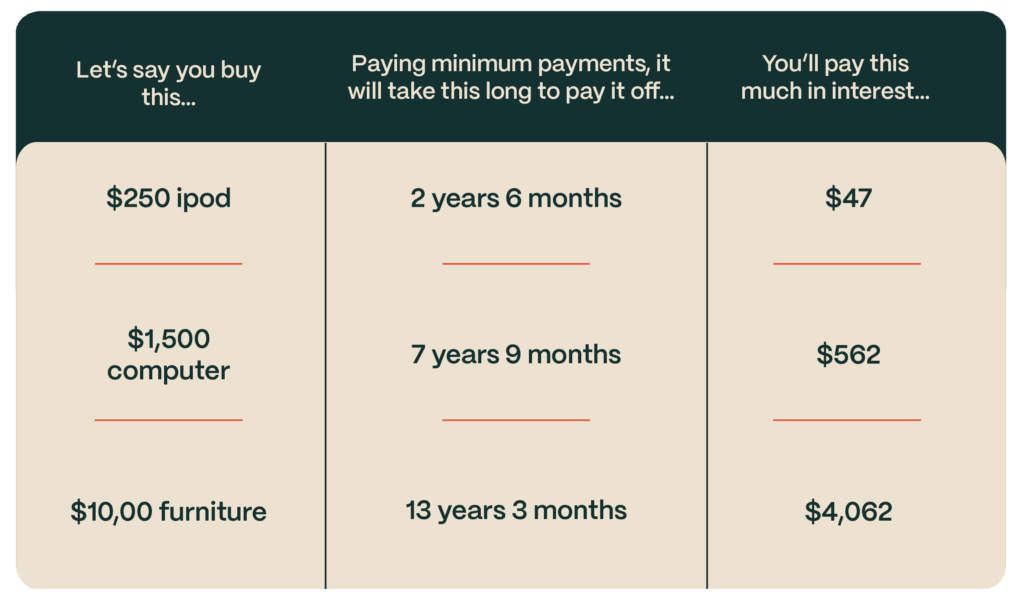
If you paid only the minimum monthly balance on your $10,000 purchase, it would take you more than 13 years and cost you more than $4,000 in interest alone. Remember, this doesn’t even factor in your “opportunity cost:“ Instead of paying off a $10,000 sofa in 13 years, if you’d invested the same amount and earned 8%, it would’ve turned into about $27,000!
How You Can Pay off Debt with Less Pain
Because loans are usually large amounts spread out over many years, the savings can be significant by paying a little extra off your loan each month. The longer the loan, the more you save.
Let’s say you have a $10,000 student loan, at a 6.8% interest rate and a 10-year repayment period. If you go with the standard monthly payment you’ll pay around $115 a month. But look at how much you’ll save in interest if you just pay $100 more each month:
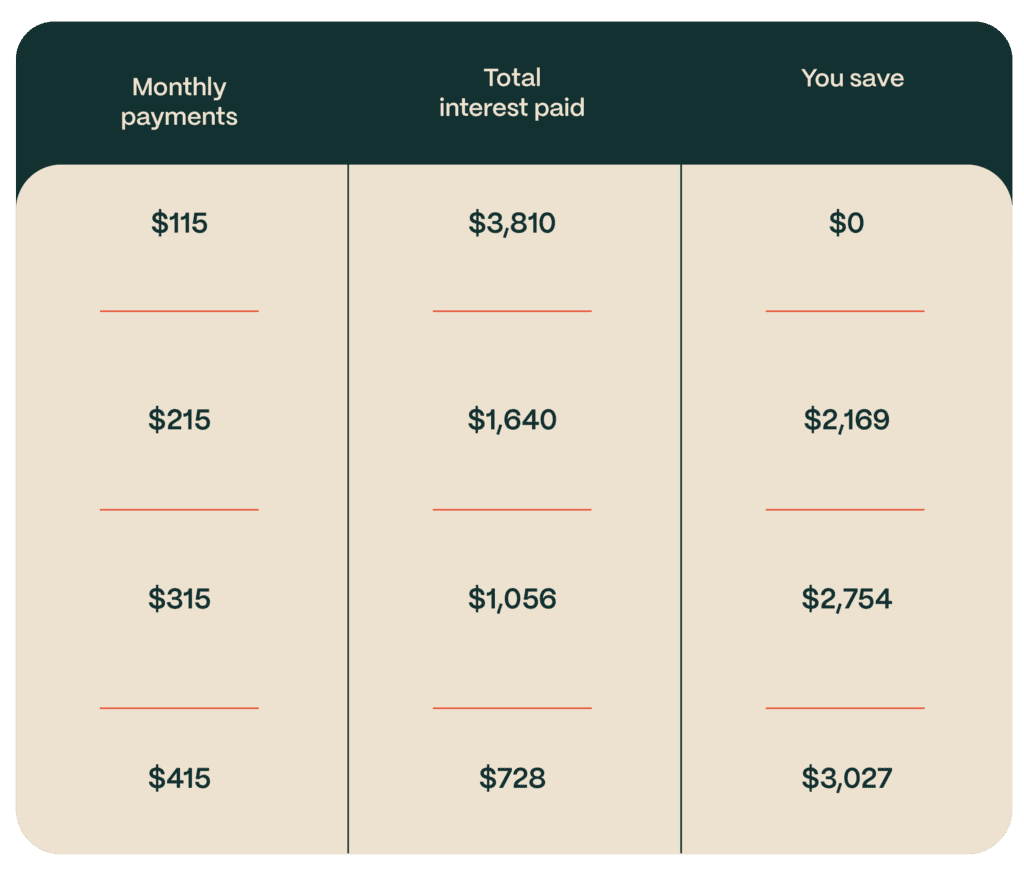
Remember, even $20 more per month can save you SIGNIFICANT amounts of money.
Note: Check out this post I made on “Paying off debt vs. investing.” The point is, if you can contribute even a small amount per month — whether to investments or any loans — the benefits can be huge.
Another example:
Dumb Dan vs. Smart Sally
- Paying off $5,000 of Credit Card debt at 14% APR
- Minimum Payments Equal Maximum Pain.
- Dumb Dan pays the minimum monthly payment

- Smart Sally pays twice the minimum monthly payment

How to Get Your Credit Score and Free Credit Report
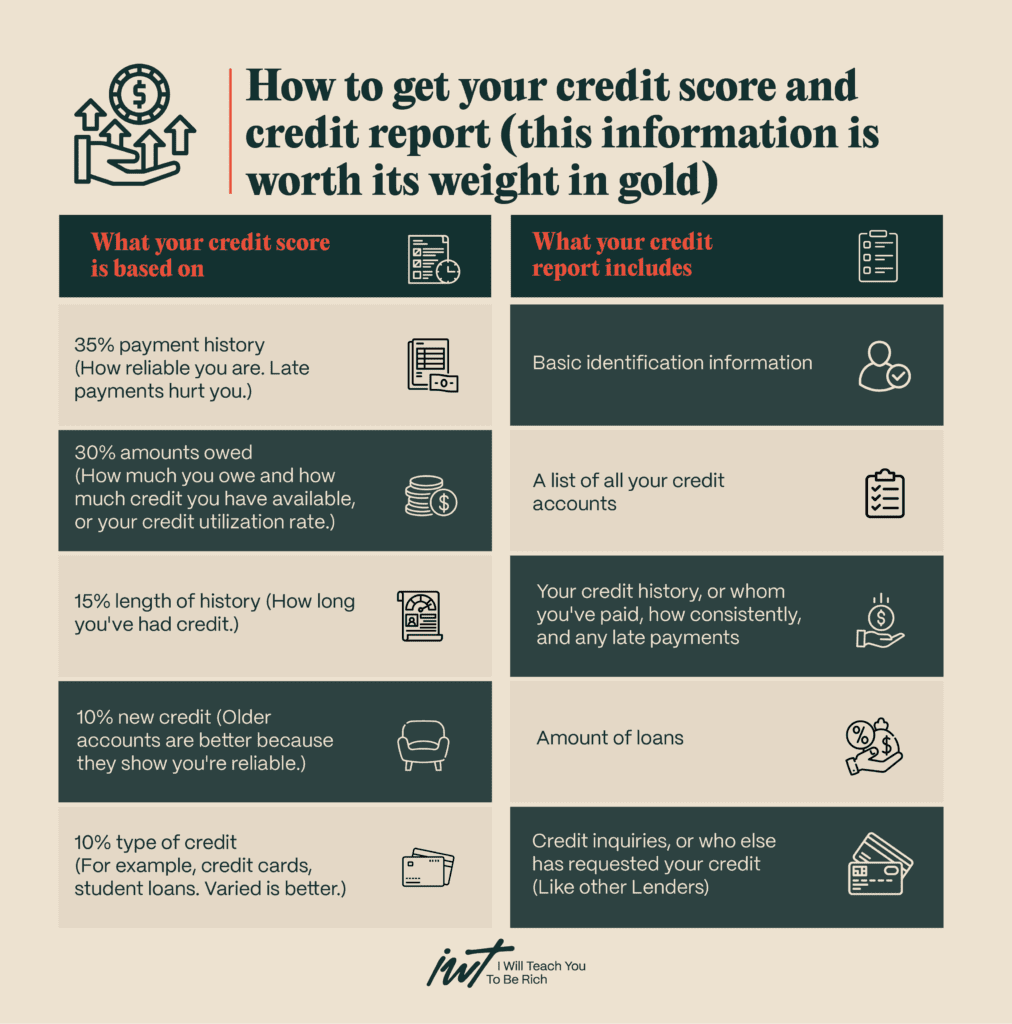
Finally, 5 rules about credit cards to live by
- Interest Rates: Interest rate doesn’t matter if you don’t carry a balance. The interest rate is irrelevant as long as you’re paying off your entire balance each month. Don’t keep a balance.
- Use a Rewards Card: The vast majority of people should use a rewards card. If you’re already spending money, you should be rewarded for it. Exceptions are people who can’t qualify, who should instead use a secured credit card.
- Travel Cards: I prefer travel cards over cash back. Most people would benefit more from travel rewards than from cash back. I describe the details of why in my book. For some reason, people get really mad when I make this recommendation, but I don’t care.
- General Reward Cards: I prefer general rewards cards, not airline-specific cards. Unless you fly a majority of flights on the SAME airline, I prefer a general travel card instead of an airline-specific card (like a United card). For example, I fly Jetblue and Virgin a lot, so I want a travel card that I can redeem on multiple airlines, not just one.
- Annual Fees: Annual fees are not Satan’s spawn. I know it may be blasphemy to personal-finance “experts,” but I’m willing to pay an annual fee! OMG! This is why you can call me RTR: Ramit The Rebel. In some cases, there are no-fee versions of the card, so you should always calculate if you spend enough to justify it. Still, $65/year is just not that significant to my financial situation anymore.
Bonus Rule
I am merciless about using my credit card perks, which can easily be worth $1,000/year. DO THIS.
Part 6 Earning more: The next step to living a Rich Life
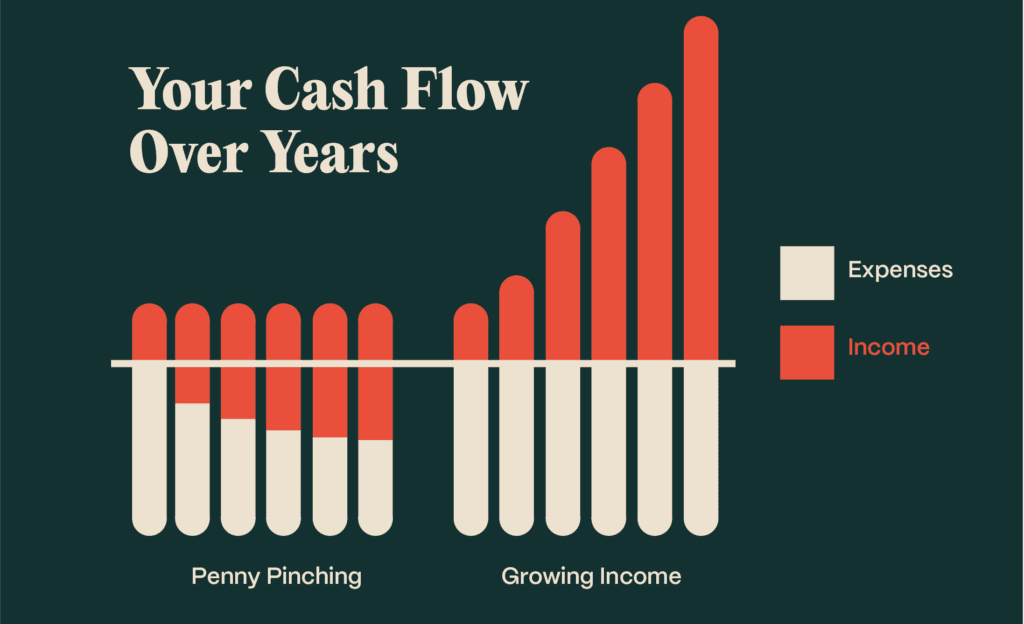
Now that you’ve learned how to build a bulletproof financial system and put thousands of dollars back into your pocket, you’re well on your way to living a Rich Life – filled with more money, more success, and more FUN. The steps in this guide are essential to making your money work for you, not the other way around. But this is just the beginning.
Remember this life-changing fact: there’s a limit to how much you can save but no limit to how much you can earn.
Earning More Money is the Fastest and Biggest Way to Improve your Financial Power
And the rewards can be huge — from an extra $1,000 a month in side income, to a 5-figure raise multiplied over your lifetime, or the freedom of earning money from an online business.
If you want more help creating your money plan, join my Money Coaching program today! Work with me and a community of peers to get your money on the right track.